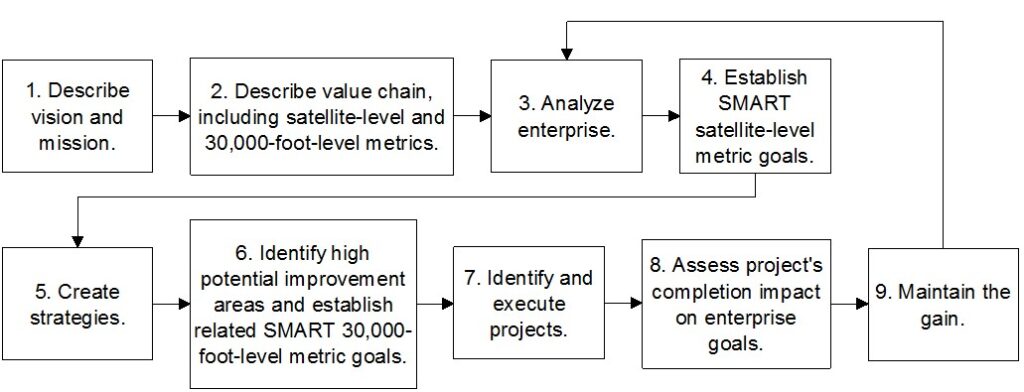The Integrated Enterprise Excellence (IEE) business management system consists of nine steps.
The IEE system’s nine steps are:
Each step of the IEE system is described below. Included is an explanation for each step (from Leadership System 2.0, Appendix A):
- Includes the company’s vision, mission, values, and responses to Jim Collins’ three-circle questions about a business: What can you be the best in the world at? What drives your economic engine? What are you deeply passionate about? (Collins 2001). High-level statements created in a traditional executive retreat often could be considered an aspect of this first step of the IEE system, which provides direction for the subsequent eight steps.
- The organization creates an IEE value chain, which includes its satellite-level and 30,000-foot-level performance metrics. An IEE value chain describes what an organization does and how it measures what is done. For an organization, an IEE value chain should maintain fundamental consistency over time, independent of leadership, competition, and environmental changes. However, the specifics of what is done in an organization’s IEE value chain should be enhanced continuously to make the enterprise, as a whole, better over time. The identification and execution of enterprise-as-a-whole enhancement activities are what the next steps of the IEE 9-step system provide.
- In ‘Analyze enterprise,’ the current state of high-level value-chain metrics are evaluated collectively with other information such as VOC, TOC information, and competitive analyses. This analysis should use statistical techniques, when appropriate, to determine the strengths and shortcomings of an organization for providing direction in the execution of Step 4 through Step 7.
- This step of the 9-step system states’ Establish SMART satellite-level metric goals.’ In IEE, satellite-level measures are to be financial. This step’s objective, as the response to underlying processes, is to have a numerical quantity that is consistent with fulfilling step 1’s organizational vision and mission statements and satisfying customer needs. For a for-profit organization, an appropriate financial satellite-level goal might be a mean monthly EBITDA objective. A step 4 goal does not need to be an enhancement to the satellite-level metric’s current response level but could be the continuance of the organization’s current response level. For government, schools, non-profits, and other similar organizations, EBITDA, or any measure of profit or revenue, may not be an appropriate encompassing measurement to address in this step. For these situations, there is a need for an alternative high-level organizational performance measurement for this step. Non-profits and government agencies might state that money are not relevant to them. However, there is still a necessity for the management of expenses in non-profits, government agencies, and schools, which can address step 4’s monetary goal objective. For non-profit organizational situations, a step 4 satellite-level metric goal might be ‘mean monthly operating expenses of 33.4 million dollars.’ For this situation, the intention would be to enhance organizational processes so that there is an enrichment in the organization’s deliverables that is consistent with this step’s stated satellite-level metric goal.
- The results from Steps 1—4 provide input to strategy creation.
- Identify high potential improvement areas and establish 30,000-foot-level performance metric goals. An enterprise improvement plan (EIP) graphic presents the results of this work.
- Identify and execute process improvement projects that improve operational 30,000-foot-level metrics and benefit the enterprise as a whole.
- Assess how the completion of projects impacts the achievement of step 4’s enterprise goal. An EIP is to show the alignment of undertaken projects to the needs of the enterprise and step 4’s fulfillment. The staging of a project’s 30,000-foot-level to an enhanced level of performance shows the amount of statistical benefit achieved to a metric through a project’s execution.
- Error-proofing a process is the best means of process control; however, that is not possible for all situations. A high-level metric-tracking control methodology is available by the periodic monitoring of organizational 30,000-foot-level process-output responses to ensure nothing has degraded. EPRS software provides a means for automatic updates for a project’s 30,000-foot-level metric in the organization’s IEE value chain, which can be monitored periodically for degradation so that there will be timely corrective action when appropriate.
Implementing the 9-step IEE Business Management System
A more detailed description of the IEE system and implementation details are provided in the books:
- Management 2.0: Discovery of Integrated Enterprise Excellence
- Leadership System 2.0: Implementing Integrated Enterprise Excellence
- Integrated Enterprise Excellence, Vol. II Business Deployment: A Leaders’ Guide for Going Beyond Lean Six Sigma and the Balanced Scorecard
- Integrated Enterprise Excellence, Vol. III Improvement Project Execution: A Management and Black Belt Guide for Going Beyond Lean Six Sigma and the Balanced Scorecard
Software is available to implement the IEE business management system.
Contact Us to set up a time for a discussion on how your organization might gain much from an Integrated Enterprise Excellence Business Management system implementation.

